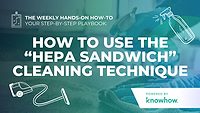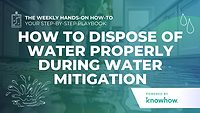Weekly Hands-on How-To powered by KnowHow
How To Use Submersible Pumps and Truck Mounted Extractors

All images provided by KnowHow.
When disaster strikes and water fills spaces it was never meant to be, speed is everything. Whether it’s a flooded basement, a construction site overwhelmed by rain, or stormwater wreaking havoc, the ability to extract water efficiently can mean the difference between recovery and a total loss. For restorers, submersible pumps and truck-mounted extractors are the best tools to get this job done.
But using these tools isn’t just about plugging them in and getting to work. Selecting the right equipment, placing it properly, and following best practices can elevate your extraction efforts from average to outstanding. In this how-to, powered by KnowHow, we’ll break down the essential steps for mastering water removal, ensuring your team can handle any waterlogged situation with precision and confidence.
Let’s dive in and turn that pool of problems into a success story.
Step 1: Choose the Right Submersible Pump for the Job
Selecting the right submersible pump is the foundation of an efficient water extraction process. The pump must match the unique demands of the task, ensuring effective performance without overloading or underutilizing the equipment.
- Volume: Consider the total volume of liquid to be removed. Larger bodies of water require pumps with higher flow rates.
- Depth: Evaluate the depth at which the pump will be submerged to ensure the pump's head capacity is sufficient.
- Liquid Type: Account for the type of liquid (e.g., clean water, muddy water, or hazardous liquids) to avoid equipment damage.
- Features: Look for special features, such as debris-handling capabilities or automatic shutoff, to optimize the pump for your specific conditions.
A thoughtful selection process ensures reliability and maximizes efficiency when removing water.
Step 2: Determine the Ideal Placement of the Submersible Pump
Proper placement is critical for maximizing the pump’s efficiency and minimizing operational risks. Identify the area where the water has accumulated the most, or continues to accumulate.
- Low Point: Choose the lowest point in the affected area, as water naturally flows there, making it the optimal extraction point.
- Stability: Position the pump on a stable surface to prevent shifting during operation.
- Accessibility: Ensure the pump is free of obstructions and has direct access to the drainage point.
By taking these factors into account, you’ll set the stage for a smooth and effective water extraction process.

Step 3: Properly Install and Secure the Submersible Pump
To ensure safe and efficient operation, installing and securing the submersible pump correctly is crucial.
- Position the pump in the selected location, ensuring it is fully submerged.
- Attach hoses or pipes according to the manufacturer’s instructions, securing all connections tightly to prevent leaks.
- Connect the pump to a grounded power supply compatible with its specifications.
- Double-check connections and seals to guarantee everything is secure before starting the pump.
Taking these precautions minimizes the risk of operational errors and ensures effective water removal.
Step 4: Operate the Submersible Pump Safely
Operating the submersible pump safely protects both the equipment and the personnel involved. To do so, follow these guidelines:
- Disconnect all power sources before setup or maintenance.
- Inspect the pump for damage, such as frayed cords or leaks, before use.
- Submerge the pump securely in the designated location.
- Connect the power source following manufacturer instructions and start the pump.
- Monitor for unusual noises, vibrations, or performance irregularities, and be ready to shut it off immediately if issues arise.
Once finished, disconnect the power, remove the pump from the liquid, and store it in a dry, secure location.
With the submersible pump tasks complete, you’ve tackled one of the most versatile and efficient tools for water extraction. These pumps are perfect for addressing water accumulation in confined or hard-to-reach spaces. However, they will not be the right tool for all water extraction challenges. For larger-scale operations or situations requiring rapid, high-volume water removal, truck-mounted extractors are the go-to solution.
Truck-mounted extractors combine powerful suction capabilities with mobility, making them essential for expansive or heavily affected areas. Let’s explore how to use truck-mounted extractors effectively and understand why they’re indispensable for large-scale water removal efforts.

Step 5: Utilizing a Truck-Mounted Extractor for Efficient Water Extraction
Truck-mounted extractors are invaluable for large-scale water extraction efforts. Their high suction power and mobility make them ideal for removing water from expansive or heavily affected areas.
- Position the extractor near the water source for easy access.
- Connect hoses securely to the designated outlets, ensuring a tight fit to avoid leaks.
- Power on the extractor and adjust settings for optimal suction power and flow rate.
- Monitor the process closely, ensuring water is being efficiently removed.
- After extraction, power off the machine, disconnect hoses carefully, and inspect for any issues.
The truck-mounted extractor ensures rapid and thorough water removal, streamlining the dewatering process.
Step 6: Operating the Truck-Mounted Extractor and Adjusting Settings
Proper operation of the truck-mounted extractor ensures its efficiency and longevity.
- Position the extractor securely near the water source and check that it’s on stable ground.
- Verify all hose connections are secure before powering up.
- Turn on the extractor and adjust settings to match the specific demands of the job, such as suction power and hose length.
- Position the extraction hose properly within the water source for maximum efficiency.
- Monitor the operation for consistent performance, adjusting as necessary.
- After completing the extraction, power down the machine, disconnect all hoses, and prepare the equipment for transport or storage.
By following these steps, the truck-mounted extractor can handle even the most challenging water extraction tasks with ease.
Be Ready For Any Catastrophe With KnowHow
Water extraction is one of the most urgent and high-stakes tasks in restoration, and KnowHow ensures your team is equipped to tackle even the most challenging tasks. With instant access to SOPs, step-by-step guides, and training resources, your crews are never left guessing. And now, with our new Catastrophe Training Toolkit, you’ll have the specialized knowledge you need to respond confidently to hurricane, flood, and other disaster-related water damage scenarios.
Visit tryknowhow.com to explore the Catastrophe Training Toolkit and see how KnowHow can elevate your team’s performance, one extraction at a time.
Looking for a reprint of this article?
From high-res PDFs to custom plaques, order your copy today!





